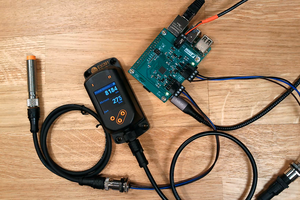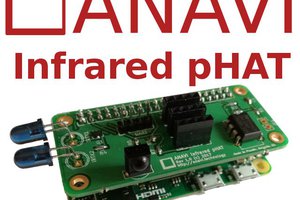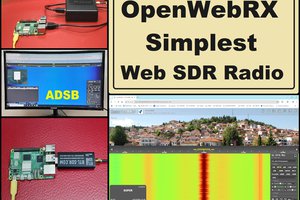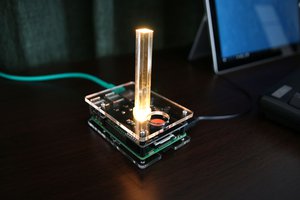PiEEG offers a seamless and affordable solution for capturing brain signals and unlocking their potential for various applications. Join us in revolutionizing the field of neuroscientific exploration and practical implementation with PiEEG.
Presentation
Robot toy control via blinking
In the lower graph demonstrated only 1/8 of the upper graph from the right side after The Fast Fourier Transform (FFT)
1. Demonstration - the EEG signal (upper graph) converted to a Fourier series (lower graph). We can see in the lower graph for various frequency ranges, dependence amplitudes from the frequency of blinking (5 Hz and 3 Hz)
2. We set the threshold to the amplitude and connected two diodes. If the amplitude (lower graph) at a frequency of 1-3 Hz becomes more than the threshold, then the upper LED will light up.
If the amplitude (lower graph) at a frequency of 3-5 Hz becomes more than the threshold, then the lower LED will light up.
3. Everything is the same, but instead of diodes, we connected output discrete signals to the toy radio control panel and controlled the mouse (ahead, back).
Instead of a toy mouse, you can connect whatever you want.
Everybody can do this device for free himself, all needed sources available on my GitHub
https://github.com/HackerBCI/EEGwithRaspberryPI
or use my instructions from here
My papers about PiEEG (all papers, all research, and work were made in my free time outside of academic activity, without any financial or other types of support)
1. Rakhmatulin, I., Parfenov, A., Traylor, Z. et al. (2021). Low-cost brain computer interface for everyday use. ExpBrain Res 239, 3573–3583. https://doi.org/10.1007/s00221-021-06231-49
2. Rakhmatulin, I. (2021). ironbci - Open-source Brain-computer interface with the embedded board to monitor the physiological subject's condition and environmental parameters arXiv:2111.03656 https://arxiv.org/abs/2111.03656
3. Rakhmatulin, I . (2021). The electronic board to replace the reference voltage on the earlobe for EEG measurement. March 2021Measurement 173 DOI: 10.1016/j.measurement.2020.108673 https://www.sciencedirect.com/science/article/abs/pii/S0263224120311854
4. Rakhmatulin, I. et al. (2021). Raspberry PI Shield - for measure EEG (PIEEG). Conference: 2021 5th International Conference on Electrical, Electronics, Communication, Computer Technologies and Optimization Techniques (ICEECCOT). DOI: 10.1109/ICEECCOT52851.2021.9707969 https://ieeexplore.ieee.org/document/9707969
5. I Rakhmatulin, S Volkl. (2022). Brain-Computer-Interface controlled robot via RaspberryPi and PiEEG, arXiv preprint arXiv:2202.01936 https://arxiv.org/abs/2202.01936
6. Rakhmatulin, I. (2020). Review of EEG Feature Selection by Neural Networks. Int. J. Sci. Bus. 2020, 4, 101–112. http://dx.doi.org/10.2139/ssrn.3675950
7. Rakhmatulin, I. (2020). Deep learning and machine learning for EEG signal processing on the example of recognizing the disease of alcoholism. https://doi.org/10.1101/2021.06.02.21258251
8. I Rakhmatulin, S Volkl. (2022). PIEEG: Turn a Raspberry Pi into a Brain-Computer-Interface to measure biosignals. arXiv:2201.02228 https://arxiv.org/abs/2201.02228
Media about PiEEG
https://hackaday.com/2023/04/03/pieeg-offers-affordable-brain-computer-interface/
https://www.raspberrypi.com/news/raspberry-pi-to-brain-interface/
https://spectrum.ieee.org/neurotechnology-diy
https://www.tomshardware.com/news/control-a-raspberry-pi-with-your-mind-and-pieeg
Read more » Ildar Rakhmatulin
Ildar Rakhmatulin
 Andreas Lau
Andreas Lau
 Leon Anavi
Leon Anavi
 mircemk
mircemk
 Tobias Kuhn
Tobias Kuhn